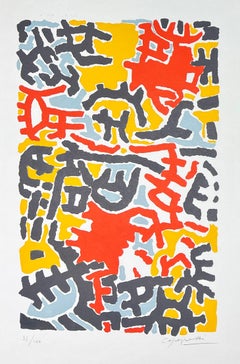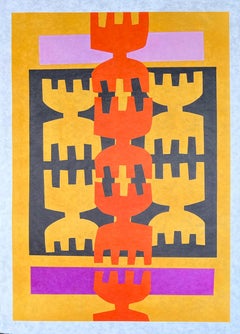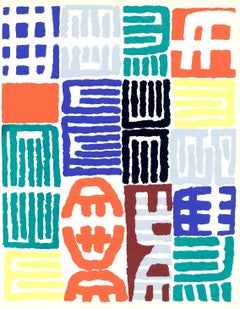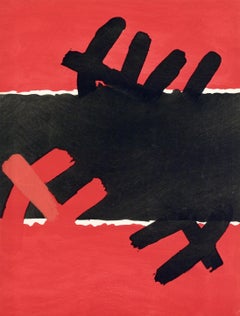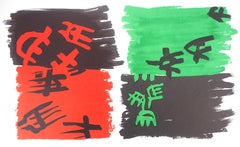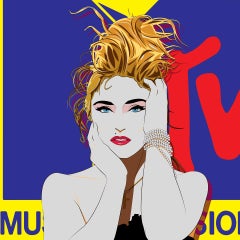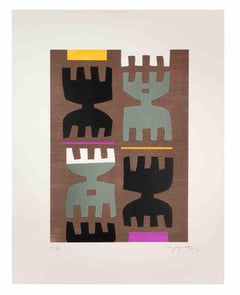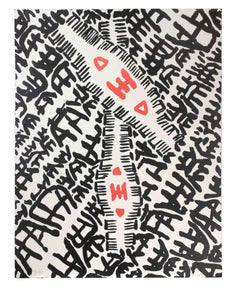Giuseppe Capogrossi Abstract Prints
to
3
2
1
2
1
Overall Width
to
Overall Height
to
3
2
1
15
668
209
165
159
6
4
1
1
4
2
4
2
1
1
4
2
Artist: Giuseppe Capogrossi
Giuseppe Capogrossi Iconic Comb Design "Superficie 324" Serigrafia
By Giuseppe Capogrossi
Located in Detroit, MI
"Superficie 324" is a 1988 screen print (serigraph) of a 1959 painting by Capogrossi. This is one of his famous "comb" or "fork" works that he perfected in the 1950s and continued to create for the remainder of his life. The blocks of primary red and yellow colors give a bright, joyful feel and contrast to the strong bold black that was Capogrossi's consistent color for the "combs". With no allegorical, psychological, or symbolic meanings, these structural elements could be assembled and connected in countless variations. Intricate and insistent, Capogrossi's signs determined the construction of the pictorial surface. This piece is identified along one side: Giuseppe Capogrossi By SIAE 1988 Silvio Zamorani Editor Via Saccarelli, 9 10144 Torino Italy Tel. (39)(11) 4730554 Progetto Grafico (Graphic Project): Studio Walter Benjamin. Serigrafia (Screen Print): BISI Torino.
Capogrossi was born in Rome. After obtaining a degree in law in 1923–1924, he decided to study painting with Felice Carena at Accademia di Belle Arti di Roma. In 1927 Capogrossi embarked on a formative trip to Paris together with fellow artists and acquaintances Fausto Pirandello, Corrado Cagli and Emanuele Cavalli...
Category
1950s Abstract Expressionist Giuseppe Capogrossi Abstract Prints
Materials
Screen
Giuseppe Capogrossi (1900-1972) - Coloured lithograph on paper - 1952
By Giuseppe Capogrossi
Located in Varese, IT
Lithographie.
Coloured lithograph on paper, edited in 1952.
Limited edition of 120 copies, numbered as 33/120 in lower left corner.
Hand-signed by artist in pencil in the lower righ...
Category
1950s Pop Art Giuseppe Capogrossi Abstract Prints
Materials
Paper, Lithograph
Giuseppe Capogrossi (1900-1972) - Lithograph on Japanese paper - 1970
By Giuseppe Capogrossi
Located in Varese, IT
Quarzo N° 4
Rare deluxe issue lithograph printed on extremely fine Japanese paper, edited in 1970.
Limited edition of 15 copies on Japanese paper and some artist's proofs, numbered ...
Category
1970s Pop Art Giuseppe Capogrossi Abstract Prints
Materials
Paper
Giuseppe Capogrossi, Untitled I, from XXe Siecle 1958
By Giuseppe Capogrossi
Located in Southampton, NY
This exquisite lithograph by Giuseppe Capogrossi (1900–1972), titled Sin titulo I (Untitled I), from the album XXe Siecle, Nouvelle serie, XXe Annee, No. 10 (double), Mars 1958, orig...
Category
1950s Modern Giuseppe Capogrossi Abstract Prints
Materials
Lithograph
$956 Sale Price
20% Off
Giuseppe Capogrossi, Red and Black Surface, from XXe Siecle, 1957
By Giuseppe Capogrossi
Located in Southampton, NY
This exquisite lithograph and pochoir by Giuseppe Capogrossi (1900–1972), titled Surface Rouge et Noire (Red and Black Surface), from the album XXe Siecle, Nouvelle serie, No. 9 (dou...
Category
1950s Modern Giuseppe Capogrossi Abstract Prints
Materials
Lithograph
Giuseppe Capogrossi, Lithograph 75, from XXe Siecle, 1969
By Giuseppe Capogrossi
Located in Southampton, NY
This exquisite lithograph by Giuseppe Capogrossi (1900–1972), titled Litografia 75 (Lithograph 75), from the album XXe Siecle, Nouvelle serie, XXXIe Annee, No. 33, Decembre 1969, ori...
Category
1960s Modern Giuseppe Capogrossi Abstract Prints
Materials
Lithograph
$716 Sale Price
20% Off
Related Items
Wild Pastels (XL)
By Lee Herring
Located in Deddington, GB
Wild Pastels (XL) by Lee Herring [2021]
original
Mixed Media
Image size: H:96 cm x W:98 cm
Complete Size of Unframed Work: H:96 cm x W:98 cm x D:0.1cm
Sold Unframed
Please note that...
Category
21st Century and Contemporary Pop Art Giuseppe Capogrossi Abstract Prints
Materials
Paper
Agent X, Madonna (True Blue), Celebrity Art, Bright Pop Art, Statement Art
By Agent X
Located in Deddington, GB
Agent X
MADONNA (TRUE BLUE)
Limited Edition Giclee Print
Edition of 50
Paper Size: 101 cm x 101 cm x 1cm
Sold Unframed
Free Shipping
Please note that in situ images are purely an indication of how a piece may look.
Pop Art for the twenty-first century, ‘Madonna (True Blue)’ depicts the illustrious singer in all her 80s glory – red lips and thick eyebrows; iconic crucifix necklace...
Category
21st Century and Contemporary Pop Art Giuseppe Capogrossi Abstract Prints
Materials
Paper, Giclée
$851
H 39.77 in W 39.77 in D 0.04 in
Beach Horizontal
By Manfred Schwartz
Located in Astoria, NY
Manfred Schwartz (American, b. Poland, 1909-1970), Beach Horizontal Composition, Lithograph on Paper, mid 20th century, marked "artist's proof" lower left, signed in pencil and with ...
Category
Mid-20th Century Modern Giuseppe Capogrossi Abstract Prints
Materials
Paper, Lithograph
Basquiat Annina Nosei Gallery 1982 (Basquiat anatomy announcement)
By Jean-Michel Basquiat
Located in NEW YORK, NY
Jean-Michel Basquiat, Annina Nosei Gallery, New York, 1982:
Rare Basquiat announcement card published by Annina Nosei Gallery to advertise the release of ‘Basquiat Anatomy’ (a suite ...
Category
1980s Pop Art Giuseppe Capogrossi Abstract Prints
Materials
Paper, Lithograph, Offset
Roy IV.
By Roy Lichtenstein
Located in Slovak Republic, SK
A Hahnemuehle Fine Art Print, attributed to Roy Lichtenstein. Editioned 25.
Category
Mid-20th Century Pop Art Giuseppe Capogrossi Abstract Prints
Materials
Photographic Paper, Color, Archival Pigment, Digital Pigment
WALKS TALKS FLIES SWIMS AND CRAWLS, Rare Card, (Hand Signed by Ed Ruscha) Framed
By Ed Ruscha
Located in New York, NY
Ed Ruscha
WALKS TALKS FLIES SWIMS AND CRAWLS (Hand Signed by Ed Ruscha), 1992
Offset lithograph invitation card (hand signed)
Vintage Robert Miller Gallery invitation card
Boldly sig...
Category
1990s Pop Art Giuseppe Capogrossi Abstract Prints
Materials
Postcard, Lithograph, Offset
Views of Hotel Well I, from Moving Focus series
By David Hockney
Located in Aventura, FL
Views of Hotel Well I, from Moving Focus series (T. 280; DH. 67). Lithograph printed in colors on TGL handmade paper. Hand signed, dated and numbered by the artist. original Artist's...
Category
1980s Pop Art Giuseppe Capogrossi Abstract Prints
Materials
Paper, Lithograph
Art Card: The Seasons (Spring), postcard, hand signed by Jasper Johns, Framed
By Jasper Johns
Located in New York, NY
Jasper Johns
Art Card: The Seasons (Spring), hand signed by Jasper Johns, 1987
Offset lithograph postcard (hand signed by Jasper Johns)
Hand signed on the front by Jasper Johns
Prove...
Category
1980s Pop Art Giuseppe Capogrossi Abstract Prints
Materials
Postcard
Three Lovely Kozo Inoue Pastel Prints, 1980s
By Kozo Inoue
Located in New York, NY
Kozo Inoue (Japanese, 1937-2017)
Untitled, 1980
Lithograph
Sight: 22 x 31 in. (Each)
Framed: 34 x 42 1/2 x 1 in. (Each)
Signed and dated 1980 lower right
Inscribed lower left
Kozo Inoue was a contemporary Japanese printmaker. Born in Osaka, he graduated from the Department of Art History at Keio University in 1960. During life, he worked during the winter months in the Izu Peninsula and Dordogne or Paris in the summer. He is known for his surrealistic silkscreen prints. His prints can be found in the Museum of Modern Art, Paris, Royal Library of Belgium, Modern Museum of Art Osaka and the Spencer Museum of Art, to name just a few. (Bio sourced from Ronin Gallery)
Category
1980s Modern Giuseppe Capogrossi Abstract Prints
Materials
Lithograph
Rio de Janeiro
By Robert Rauschenberg
Located in Brooklyn, NY
Rio de Janeiro is a colorful, bold, graphic, and visually compelling offset-lithograph by blue chip, pop artist Robert Rauschenberg. In 1991, he was involved with th...
Category
1990s Pop Art Giuseppe Capogrossi Abstract Prints
Materials
Archival Ink, Archival Paper, Lithograph, Offset
Jules Olitski, Mozart Night, color field silkscreen for Lincoln Center, Signed/N
By Jules Olitski
Located in New York, NY
Jules Olitski
Mozart Night, 1992
Silkscreen on wove paper
Signed, dated, titled and numbered 71/108 in graphite pencil on the front
Edition 71/108
47 × 36 inches
Unframed
Silkscreen ...
Category
1990s Abstract Expressionist Giuseppe Capogrossi Abstract Prints
Materials
Screen
Keith Haring Crack Down! 1986 (vintage program)
By Keith Haring
Located in NEW YORK, NY
Keith Haring crack down! 1986: Vintage original 1986 Keith Haring illustrated Crack Down! benefit program.
This folding pamphlet was designed & illustrated by Keith Haring (a...
Category
1980s Pop Art Giuseppe Capogrossi Abstract Prints
Materials
Paper, Lithograph
Previously Available Items
Untitled - Lithograph by Giuseppe Capogrossi - 1965
By Giuseppe Capogrossi
Located in Roma, IT
Untitled is a contemporary artwork realized by Giuseppe Capogrossi in 1965.
Mixed colored lithograph.
Excellent condition.
Category
1960s Abstract Giuseppe Capogrossi Abstract Prints
Materials
Paper, Lithograph
H 30.32 in W 22.05 in D 0.08 in
Untitled - Lithograph by Giuseppe Capogrossi - 1972
By Giuseppe Capogrossi
Located in Roma, IT
Untitled is a contemporary artwork realized by Giuseppe Capogrossi in 1972.
Mixed colored lithograph ON BFK Rives Paper
Edition of 58/65.
Excellent condition.
Category
1970s Abstract Giuseppe Capogrossi Abstract Prints
Materials
Paper, Lithograph
H 25.79 in W 23.82 in D 0.08 in
"Superficie 324" Modernist Abstract Black, Red and Yellow Serigraph
By Giuseppe Capogrossi
Located in Houston, TX
Black, yellow, and red modernist abstract serigraph by Italian artist Giuseppe Capogrossi. Originally printed in 1959, the serigraph was reprinted in Italy in 1988. The piece features black abstracted shapes resembling figures with teeth-like features, contrasted against red and yellow rectangular shapes. Framed in a modern black frame.
Dimensions Without Frame: H: 19.25” x W: 15.25”
Artist Biography: Giuseppe Capogrossi was born on March 7, 1900, in Rome. In 1922 he completed his law degree but soon after devoted himself entirely to painting and joined Felice Carena's atelier. Between 1927 and 1931, Capogrossi traveled frequently to Paris, and along with Corrado Cagli and Emanuele Cavalli...
Category
1980s Abstract Giuseppe Capogrossi Abstract Prints
Materials
Color
H 42 in W 57 in D 0.5 in
Giuseppe Capogrossi - Composizione - Hand-Signed Lithography, 1957
By Giuseppe Capogrossi
Located in Varese, IT
Giuseppe Capogrossi ( 1900 - 1972 ) - Composizione - hand-signed lithography, 1957
Additional information:
Material: Lithography on Fabriano paper...
Category
20th Century Giuseppe Capogrossi Abstract Prints
Materials
Paper, Lithograph
Giuseppe Capogrossi abstract prints for sale on 1stDibs.
Find a wide variety of authentic Giuseppe Capogrossi abstract prints available for sale on 1stDibs. You can also browse by medium to find art by Giuseppe Capogrossi in lithograph, paper, screen print and more. Much of the original work by this artist or collective was created during the 20th century and is mostly associated with the abstract style. Not every interior allows for large Giuseppe Capogrossi abstract prints, so small editions measuring 23 inches across are available. Customers who are interested in this artist might also find the work of Walasse Ting, Cleve Gray, and James Brooks. Giuseppe Capogrossi abstract prints prices can differ depending upon medium, time period and other attributes. On 1stDibs, the price for these items starts at $1,400 and tops out at $1,974, while the average work can sell for $1,745.
